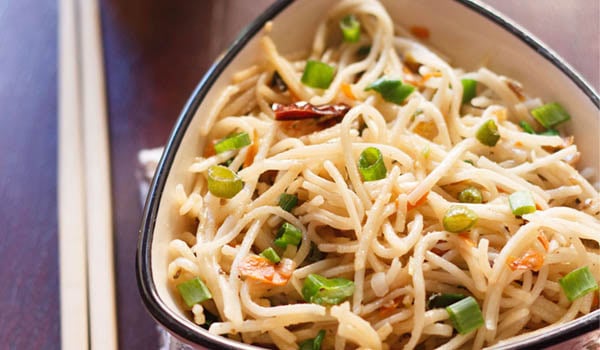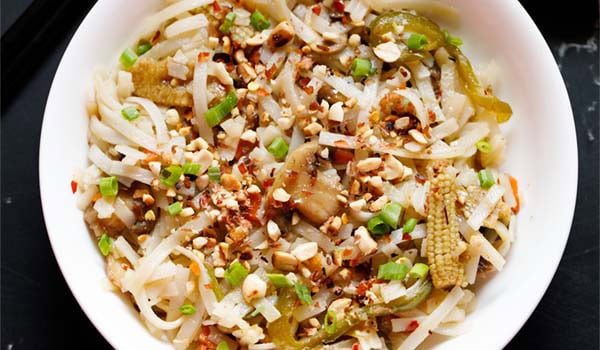Moru Curry, also known as Pulissery, is a traditional South Indian dish made with whisked curd (yogurt), coconut paste, and tempered spices, resulting in a mildly spiced, tangy curry. This comforting dish is a staple in Kerala cuisine and is typically served with steamed rice. Beautifully simple and packed with flavor, this Kerala Moru Curry recipe is sure to become a favorite in your family’s dinner rotation.

About Moru Curry
This is my mom’s Moru Curry recipe, a cherished dish from South Indian cuisine. This deliciously spiced and seasoned yogurt curry has been a family favorite for years.
A Kerala-style curry, Moru is yogurt-based and can be prepared with or without coconut. The term “Moru” translates to “buttermilk” in Malayalam. My mom’s recipe actually calls for curd or yogurt instead of buttermilk.
Sour curd is whisked with water to achieve a buttermilk-like consistency. Moru curry can also be made using traditional buttermilk derived from churning butter. In either case, the curry retains the authentic flavors I grew up with.
Also referred to as Nadan Moru Curry, Moru Charu, Kachiya Moru, or Pulissery, this dish is an integral part of the Onam Sadya feast.
Spiced with green chilies for heat, cumin for aromatic warmth, and ground coconut, this delightful dish is perfect for a hot summer day. Regardless of the name, this meal is sure to please.
Why This Recipe Works
This recipe utilizes ground coconut, green chilies, and cumin paste, all of which contribute immense flavor to the curry. It can also be made without the coconut paste, depending on your taste preferences.
Having learned from the best—my mother—this is her version of Moru Curry, and it is simply delicious.
If you’re looking to recreate this Keralan specialty at home, I highly recommend trying this delightful and straightforward Pulissery recipe.
While this dish is often served over rice, I sometimes add a variety of vegetables to transform it into a complete meal.
If you love vegetables as much as I do, I suggest trying my recipe with my favorites: taro root, ash gourd, yam, and Malabar cucumber (also known as yellow cucumber or vellarikka).
If you choose to serve it as a plain Pulissery without vegetables, don’t worry. It is rich in flavor and will surely tantalize your taste buds. Enjoy!
How to Prepare the Vegetables for This Curry
My favorite vegetables to add to Moru Curry or Pulissery include taro root (also known as arbi), ash gourd, yam, and Malabar cucumber. Follow these instructions to enhance the flavor of these vegetables:
- Taro root (arbi, chembu): Peel and steam or cook the taro roots in a pan. Then lightly fry or sauté in coconut oil before adding to the buttermilk mixture.
- Ash gourd (kumbalanga): Peel, chop, and boil or steam. Drain and add to the curd and coconut paste mixture.
- Yam: Peel, chop, and steam or boil. Strain the water and add the steamed yam to the buttermilk mixture.
- Malabar cucumber (vellarikka): Peel, remove the seeds, chop, and cook in water until tender. Drain and add to the curd mixture.
- Greens: Spinach, amaranth, and drumstick leaves are healthy options. You can either sauté the chopped leaves in coconut oil until they wilt, or blanch, mash, and then use them in the Pulissery recipe.
How to Make Moru Curry
To prepare my mom’s Moru Curry, follow these five steps. First, make your coconut paste.
1. Make Coconut Paste
1. In a spice grinder or blender, combine ½ cup of grated fresh coconut, 1 teaspoon of chopped green chilies (equivalent to 2 to 3 chilies), and 1 teaspoon of cumin seeds.

2. Add 4 to 5 tablespoons of water and grind to a smooth paste. Set aside.

2. Make Buttermilk Mixture
Now, let’s move on to step 2: preparing the buttermilk mixture.
1. In a saucepan, add 1 cup of sour curd (yogurt).
Tip: If your curd isn’t sour, let it sit at room temperature for 2 to 4 hours until it turns sour. The curd should smell slightly sour but not rancid or spoiled.
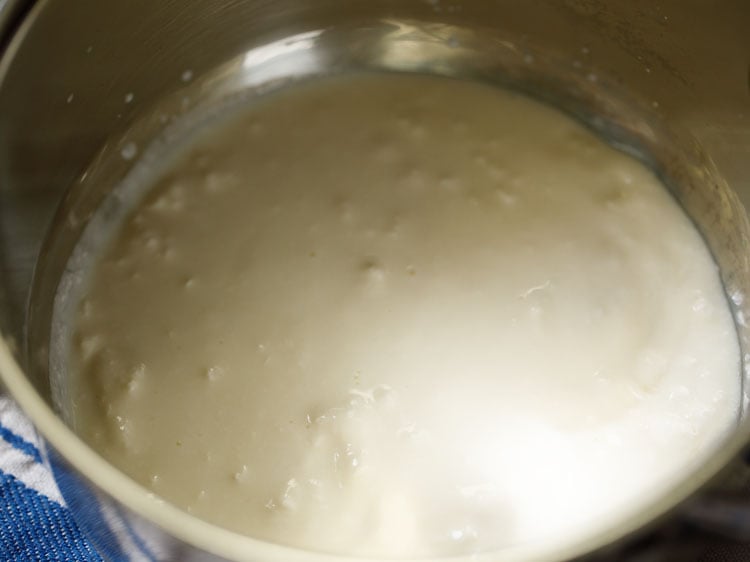
2. Add 1 cup of water and ¼ teaspoon of turmeric powder. Adjust the water based on the amount added to your coconut paste.

3. Whisk until you achieve a smooth buttermilk consistency.
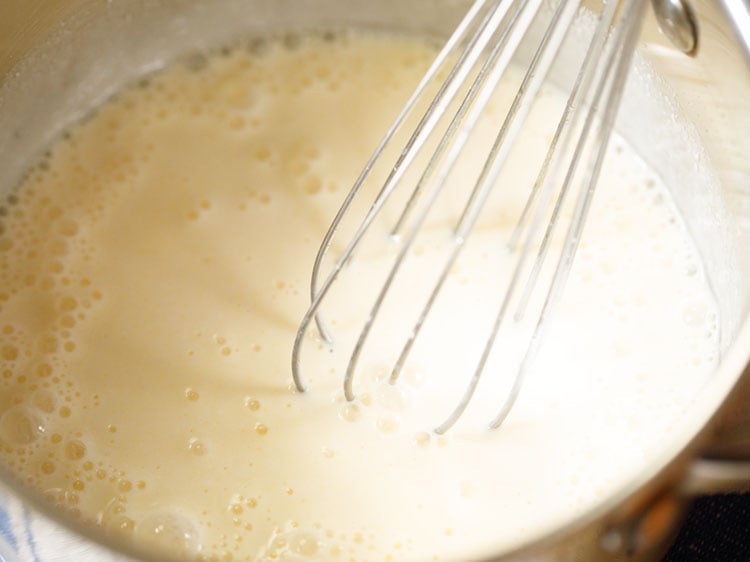
4. Incorporate the ground coconut paste from step 1.

5. Add salt to taste.

6. Mix the buttermilk with the paste and salt until well combined.
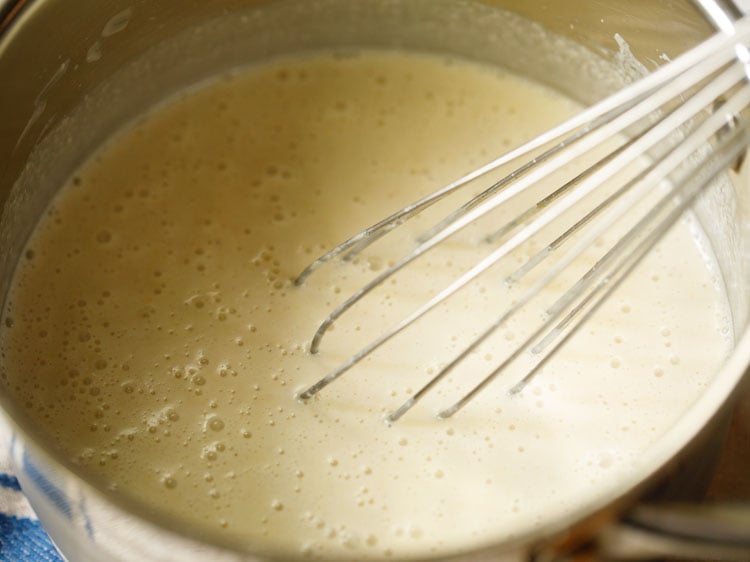
3. Simmer the Curry
1. Place the saucepan with the buttermilk-coconut mixture on the stovetop over low heat.

2. Whisk occasionally, every 2 to 3 minutes.

3. Heat until the mixture is hot, but do not allow it to boil. When steam begins to rise, remove it from the heat.
Cover and set aside. Boiling can curdle this delicate yogurt curry. Remember, the curry thickens as it cools, so you may want to keep it slightly runny if you plan to reheat it later.

4. Temper the Spices
Now, let’s move on to step 3: tempering the spices.
Tempering is a crucial step in Indian cooking. Unlike the American definition related to chocolate, in this context, it refers to extracting maximum flavor from spices.
To properly temper your spices for this Moru Curry recipe, I recommend using coconut oil for an authentic flavor.
1. Heat 2 tablespoons of coconut oil in a small pan over medium heat. Add ½ teaspoon of mustard seeds.

2. Allow the mustard seeds to crackle. This is the magical part of tempering, also known as tadka! The spices awaken with that delightful crackling sound.

3. Add 10 to 12 curry leaves, 7 to 8 fenugreek seeds, and 2 dry red chilies (broken in half, with stems and seeds removed).

4. Incorporate ¼ cup of sliced shallots or pearl onions and ½ teaspoon of finely chopped ginger.

5. Mix and sauté over low heat.

6. Sauté until the onions turn light golden or golden brown.

5. Assemble & Make Moru Curry
1. Pour the entire tempering mixture, including the oil, into the cooked buttermilk.
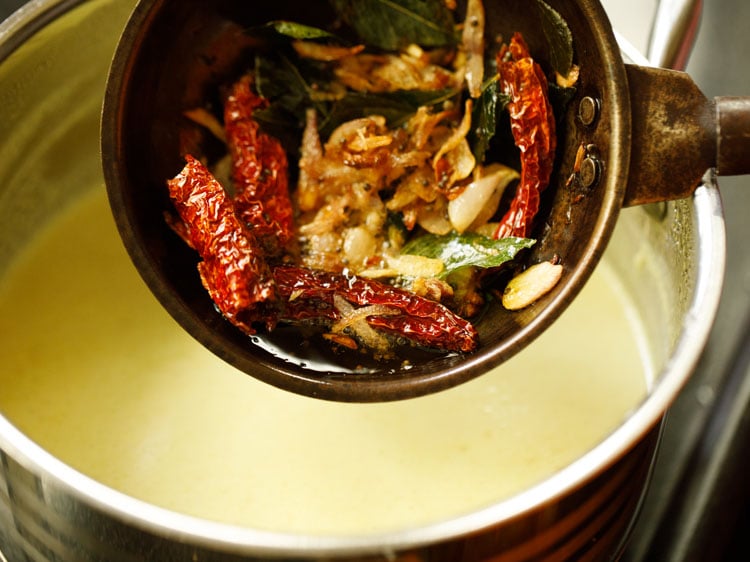
2. Cover and let the flavors infuse for a few minutes.

3. Garnish with chopped coriander leaves (optional) and serve Moru Curry hot or warm with steamed rice.
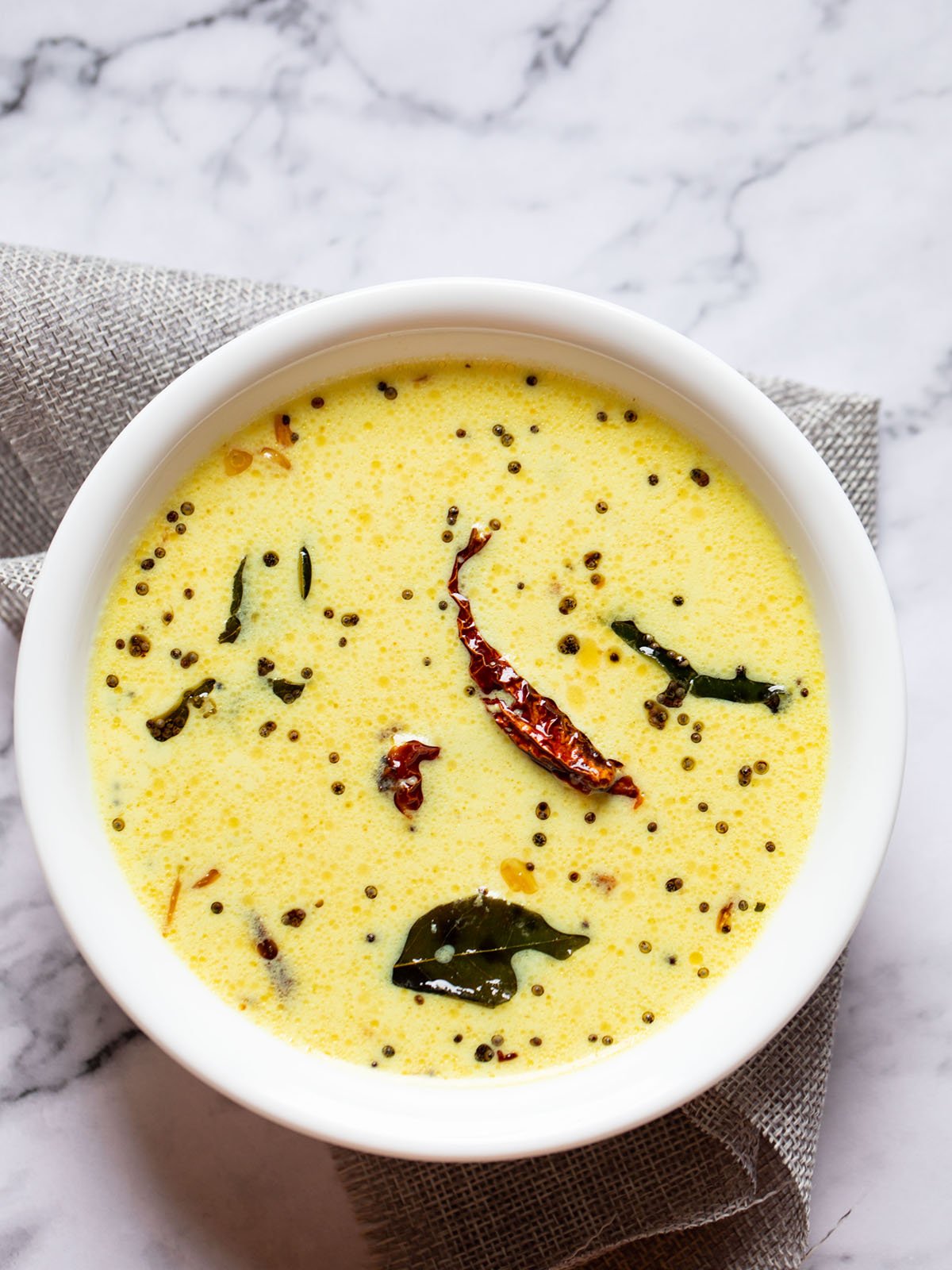
Expert Tips
- Curd: Use sour curd (yogurt) for this recipe, but ensure it is not spoiled or rancid. If the curd isn’t sour, leave it at room temperature for 2 to 4 hours until it turns sour.
- Vegetables: You can add a variety of cooked vegetables to this curry. Options include ash gourd, taro root, yam, Malabar cucumber, summer squash, zucchini, potato, pumpkin, winter squash, bell peppers, or leafy greens like drumstick or moringa leaves, spinach, amaranth, and kale.
- Coconut: You can substitute fresh grated coconut with desiccated coconut. This curry can also be made without coconut altogether.
- Substitutes: Instead of sour curd, use sour buttermilk; instead of coconut oil, use any neutral-flavored oil or ghee (clarified butter).
- Garnish: Garnish the Moru Curry with chopped coriander leaves if desired. This step can be skipped if you prefer.
- Make Ahead: Since this dish is primarily made with curd or yogurt, it is best enjoyed fresh and not prepared ahead of time or stored for later.
FAQs
As Moru Curry is made from curd, it is best served fresh. I do not recommend preparing it ahead of time. In Indian culinary culture, freshly cooked food is emphasized for health benefits.
Moru Curry or Pulissery is often served over steamed rice and can be garnished with fresh coriander leaves. I also enjoy adding cooked chopped vegetables to mine. Either way, you’re sure to love it.
You can easily substitute your favorite vegetables in this recipe. Zucchini or summer squash can replace ash gourd and Malabar cucumber, while potato can take the place of taro. Other suitable vegetables include pumpkins, winter squash, bell peppers, or leafy greens like kale, spinach, or drumstick leaves.
Certainly! If you do not enjoy the flavor of coconut or have an allergy, simply omit the coconut paste. Gently heat the buttermilk and then add the fried tempering ingredients, including half a teaspoon each of chopped green chilies and cumin seeds. You can also use ghee or a neutral oil during the tempering step.
While this recipe uses curd (yogurt) whisked with water to approximate buttermilk, you can use 2 cups of real buttermilk obtained from butter-making.
More Kerala Recipes To Try!


